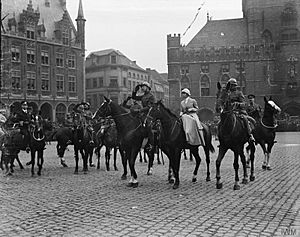Battle of Courtrai (1918) facts for kids
Quick facts for kids Battle of Courtai, 1918 |
|||||||
|---|---|---|---|---|---|---|---|
| Part of the Hundred Days Offensive of World War I | |||||||
 Liberation of Bruges - King Albert I of the Belgians with his wife, Queen Elisabeth enter Bruges on 25 October 1918 alongside Admiral Roger Keyes (far left) and the 1st Earl of Athlone (far right) |
|||||||
|
|||||||
| Belligerents | |||||||
|
|
|||||||
| Commanders and leaders | |||||||
| Casualties and losses | |||||||
| Not available | Not available 12,000 soldiers captured 550 artillery pieces captured. |
||||||
The Battle of Courtrai was a big fight during World War I. It happened in northern France and southern Belgium in October 1918. This battle is also known as the Second Battle of Belgium or the Battle of Roulers. It was part of a larger push by the Allied forces to end the war.
Contents
What Led to the Battle?
Before this battle, a group of armies called the Flanders Army Group (GAF) had already won a fight against the German 4th Army. This group included soldiers from Belgium, Britain, and France. Their leader was King Albert I of Belgium.
The Allies had broken through a strong German defense line called the Hindenburg Line further south. This allowed them to chase the German army. However, bad weather and problems getting supplies stopped their advance in early October. By the middle of the month, the Flanders Army Group was ready to attack again.
The Battle Begins
The attack started early on October 14. The Flanders Army Group attacked from the Lys River up to Diksmuide. British forces used a "creeping barrage," which was a moving wall of artillery fire. It moved very fast, expecting little resistance from the German soldiers.
By the end of the first day, British troops had captured high ground near Werviq, Menen, and Wevelghem. Further north, they took Moorslede. Belgian troops reached Iseghem, and French troops surrounded Roulers. More Belgian soldiers captured Cortemarck.
Key Moments of the Fight
- October 15: Roulers fell to the Allied forces.
- October 16: British troops held the north bank of the Lys River up to Harelbeke. They also crossed the river in several places.
- October 17: Important towns like Thourout, Ostend, Lille, and Douai were taken back by the Allies.
- October 19: Bruges and Zeebrugge were captured. The British Second Army crossed the Lys River and took Courtrai. This made the German army retreat even further south.
- October 20: Allied forces reached the Dutch border.
- October 22: British troops reached the Scheldt River from Valenciennes to Avelghem.
After the Battle
The Battle of Courtrai was a big success for the Allies. It pushed the German army back a lot. Another attack by the Flanders Army Group started on October 30. However, the war ended soon after. The Armistice (a peace agreement) was signed on November 11, 1918.
By the time the war ended, the front line had moved about 45 miles (72 kilometers) east of where it was before. It now stretched from Terneuzen to Ghent, along the Scheldt River to Ath, and then to Saint-Ghislain. This battle was an important part of the final push that led to the end of World War I.
See also
- Battle of Courtrai (disambiguation), for other battles with this name
- Charge of Burkel, a small fight on October 19, 1918, which was the last cavalry charge in Western Europe.


